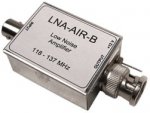I apologize for asking such a mundane question as this, but can someone please explain how power is supplied to an item such as a pre-amp? I've opted for the type of pre-amp that needs to be powered at the pre-amp itself, rather than by a power-injector.
And before anyone thinks this post is stupid, I live out in the Atlantic, and we have absolutely no suppliers of connectors & adpaters here whatsoever. Over the last couple of weeks I've purchased online an antenna & various accessories such as filters & preamps, only to discover once they arrived that no cabling was included or the connectors on the items were not the same as the ones depicted in the photos, causing me to have to order additional adapters online for such prices as $2.99, then spend close to $50 to ship them here, and then have to wait 2-3 days for them to arrive.
So, in order that the same thing doesn't happen when my pre-amp arrives (tomorrow morning), I want to place one final order for any items that I will need to power the critter.
In looking at the pre-amp itself, it looks like there's a single wire protruding from the pre-amp casing, to which I need to connect a 12-v supply. To where do I attach the other side of the power feed? In other words, if I connect the (+) end of my power feed to that lead protruding from the pre-amp, where & how do I connect the (-) end of the feed?
Thanks in advance for the above & have a great day.
And before anyone thinks this post is stupid, I live out in the Atlantic, and we have absolutely no suppliers of connectors & adpaters here whatsoever. Over the last couple of weeks I've purchased online an antenna & various accessories such as filters & preamps, only to discover once they arrived that no cabling was included or the connectors on the items were not the same as the ones depicted in the photos, causing me to have to order additional adapters online for such prices as $2.99, then spend close to $50 to ship them here, and then have to wait 2-3 days for them to arrive.
So, in order that the same thing doesn't happen when my pre-amp arrives (tomorrow morning), I want to place one final order for any items that I will need to power the critter.
In looking at the pre-amp itself, it looks like there's a single wire protruding from the pre-amp casing, to which I need to connect a 12-v supply. To where do I attach the other side of the power feed? In other words, if I connect the (+) end of my power feed to that lead protruding from the pre-amp, where & how do I connect the (-) end of the feed?
Thanks in advance for the above & have a great day.


